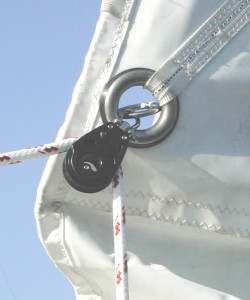Improved Ties For Portlight Curtains
Bob Bierly
August, 2006 Hull #: 255
Many of you have probably experienced the wearing out of those dainty little strips of velcro provided by Mother Catalina to hold the accordion / pleated curtains for the opening and fixed ports. Not only have mine died, but I never did like them anyway as two hands were generally insufficient to fold up the shade and pull down on two or more velcro tabs. [Note: your editor also finds them a bit of a pain: to reset any shade it’s difficult to retrieve the underneath tab- Warren]
So, here’s a simple, cheap and effective fix requiring little work, not much material and even less talent. For each port you need ten inches of flat elastic material about 1/2 inch wide. Cut the elastic into two 5- inch pieces. Form a loop by overlapping each 5 inch
You need to be logged in to see the rest of this content. Catalina380-IA members, please login.
To join please fill out a membership application (Association->Membership Application) and send a check to the address on the form.


